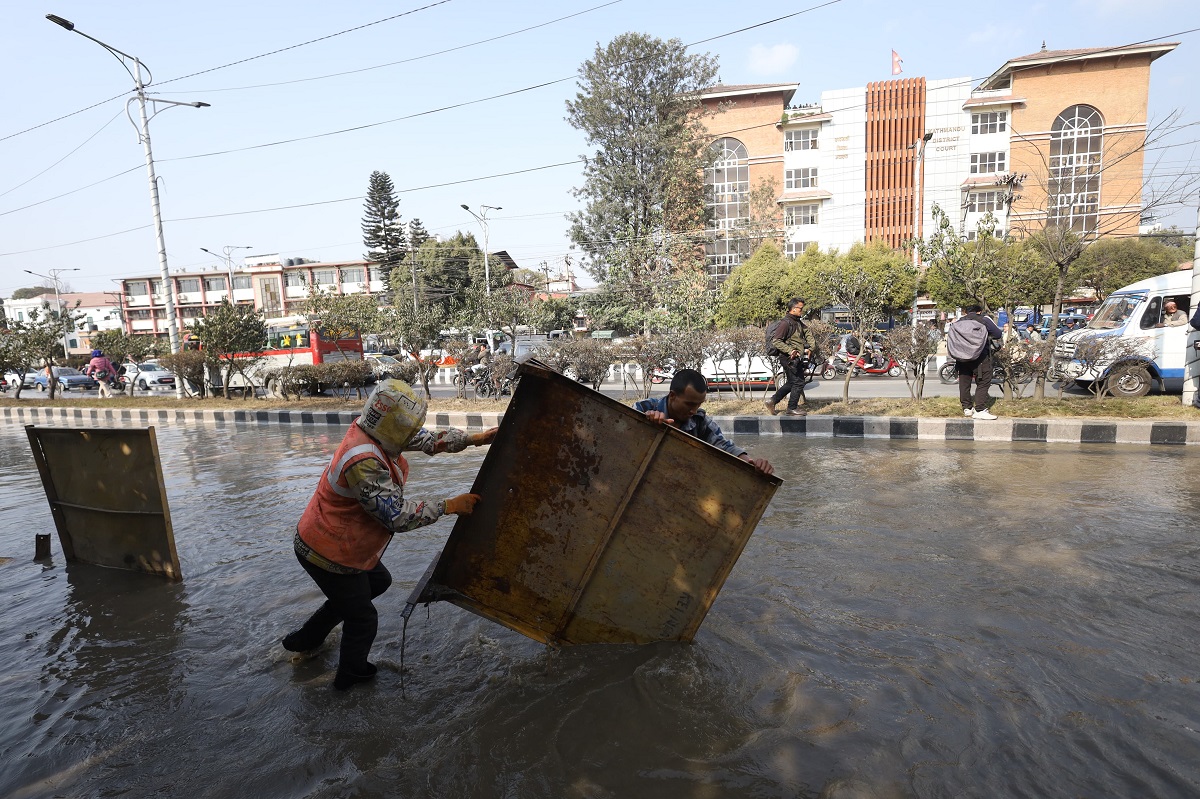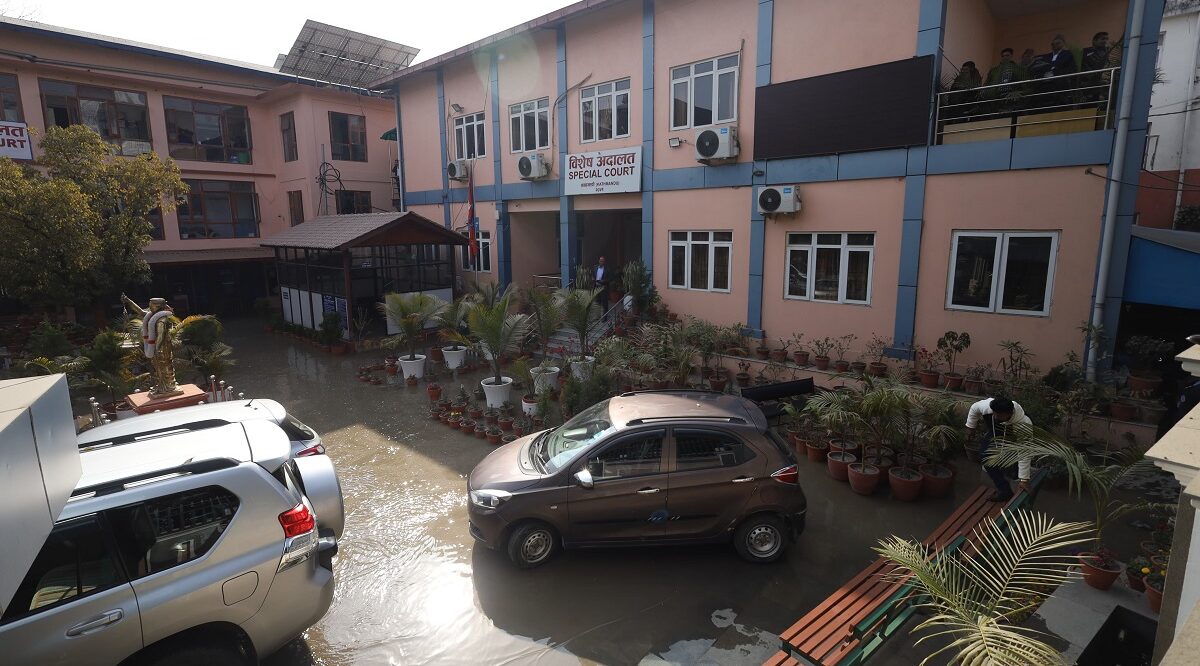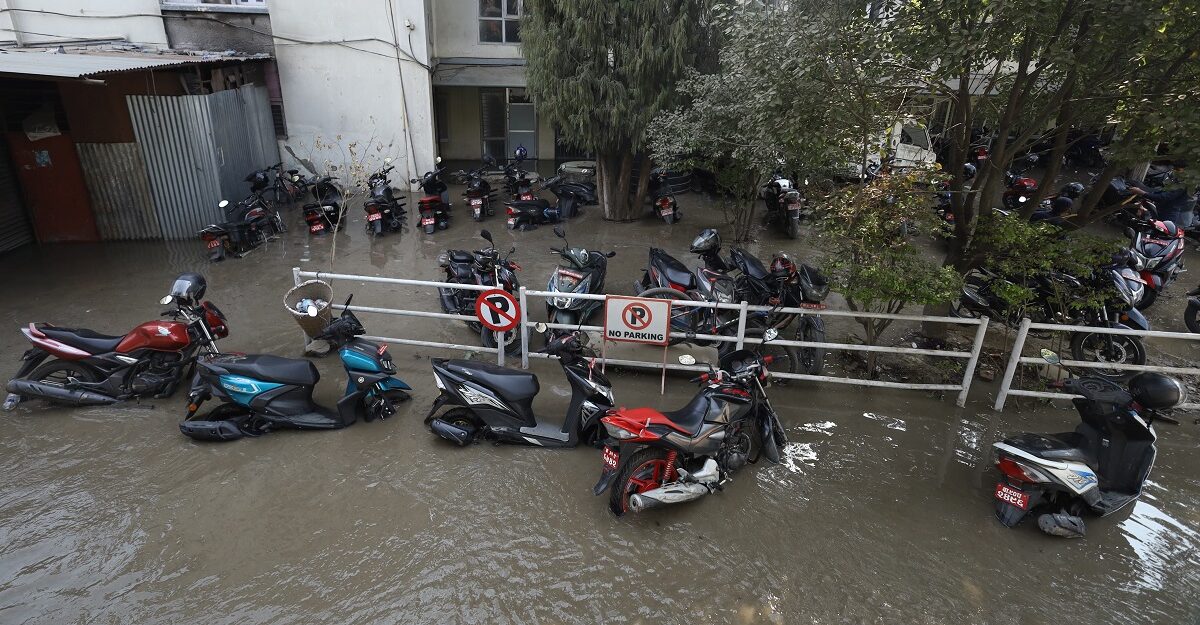KATHMANDU: A sudden flood in Babarmahal on Wednesday afternoon left homes, businesses, and government offices submerged, causing millions in damages. But unlike natural disasters that come without warning, this crisis was entirely man-made—a result of government negligence.
A burst drinking water pipe, damaged during road excavation by the Nepal Electricity Authority (NEA), sent thousands of liters of water gushing into homes and commercial establishments, leaving residents helpless.
Despite the severity of the damage, no government agency has taken responsibility. The Ministry of Home Affairs has not issued a report, the Disaster Management Authority has remained silent, and Kathmandu Metropolitan City (KMC) has shown little concern. Even Mayor Balen Shah, known for his active social media presence, has not visited the affected area.
For the victims, the silence from the government has been just as devastating as the flood itself. As families scramble to salvage what remains of their belongings and business owners count their losses, the question on everyone’s mind is the same: Who will pay for this disaster?
Businesses suffer heavy losses
The flood did not just bring water; it brought irreversible financial damage to many businesses in Babarmahal. The area, home to numerous automobile parts stores, food suppliers, internet service providers, and hostels, suffered extensive losses.
Arvin Kumar Das, a food supplier, estimated his damages at Rs 4 million, as his stored goods were ruined beyond use.
“Our food items were submerged in sewage water—completely unsellable. The insurance company won’t cover this because it’s state negligence, not a natural disaster,” he said.
The contamination of perishable items means he has to start from scratch, with no financial support from the authorities.
For businesses dealing in automobile parts, the situation is even worse. Nawaraj Shrestha, who owns a parts store in the area, estimated his losses at a staggering Rs 20 million. He explained that car parts are highly sensitive to water damage.
“Car parts rust when submerged, and lubricants become useless. This means we can’t sell anything that got wet,” he said.
His shop was flooded within minutes, leaving him no time to save his stock. “The government hasn’t even sent a representative. We pay taxes, but where is the state when we need help?”
Indira Shahi, a hostel owner, is facing an equally difficult situation. Her hostel, which houses students and working professionals, was hit hard by the flood.
“Beds, mattresses, furniture—everything was ruined,” she said. Already struggling to maintain occupancy due to economic conditions, she now faces the added burden of replacing essential items for her tenants. “We were already struggling, and now we have to replace everything. Who will compensate us?” she asked.
Even large companies were not spared. Wordlink Communications, one of Nepal’s leading internet service providers, faced technical failures as key servers and batteries were submerged. Electrical chief Rameshwor Koirala warned that the salary of employees could be affected due to the financial setbacks caused by the flooding.
“This is a major blow. When technical infrastructure is damaged like this, repairs are expensive. We are looking at serious financial implications,” he said.
Authorities downplay the crisis

When contacted for a statement, Kathmandu Ward 11 Chair Hiralal Tandukar downplayed the issue. He described the damage as minor and said the situation was under control.
“A little water entered some houses, but the damage isn’t significant,” he said adding, “a small wall collapsed, and the mud has been removed.”
However, these statements starkly contradict the ground reality. Residents and business owners were still seen pumping water out of their buildings 24 hours later. The scene in Babarmahal painted a very different picture—mud-covered floors, damaged goods stacked outside shops, and people desperately trying to clean up.
For those affected, the government’s response, or lack thereof, has only deepened their frustration. Many believe that officials are trying to downplay the crisis to avoid accountability.
“They don’t want to admit how bad this is because then they would have to compensate us,” said a business owner who wished to remain anonymous.
‘Do we have a functioning government?’

The lack of state intervention has left residents feeling abandoned. Among them is Dr Bhimarjun Acharya, a well-known legal expert and a resident of Ward 11. He condemned the government’s inaction, stating that the incident reflected a complete failure of governance.
“The state’s presence was invisible. If citizens must bear losses caused by government negligence, how can we trust our leaders? People are psychologically affected, and their livelihoods are at risk,” he said.
Dr Acharya also raised concerns about the legal implications, pointing out that government agencies should be held accountable for the damage.
According to legal experts, when infrastructure projects cause harm to private properties, the state is liable for compensation. However, Nepal’s bureaucratic system makes it nearly impossible for ordinary citizens to receive compensation in such cases.
“If this were a private company, they would be sued immediately. But because it’s the government, nobody takes responsibility,” said a lawyer working on property disputes.
Demands for accountability and compensation
Those affected by this disaster are now demanding immediate action. Business owners and residents argue that since the damage was caused by government work, they should not be the ones paying for it.
“There must be compensation. The Nepal Electricity Authority dug up the road without proper planning. We are suffering because of their mistakes,” said one business owner. Others echoed similar sentiments, calling for a formal investigation into the incident.
With Kathmandu Metropolitan City and the Nepal Government yet to take responsibility, the incident highlights the systemic lack of coordination and accountability in Nepal’s infrastructure projects. Experts believe that such disasters will continue to happen unless government agencies improve their planning and oversight.
As residents struggle to recover, they are left with one burning question: who will pay for their losses? If the government remains silent, victims may be forced to take legal action. However, as history has shown, fighting the state’s negligence in court is a long and exhausting battle—one that most people cannot afford.
For now, the floodwaters may have receded, but the damage—both financial and emotional—remains.









Comment